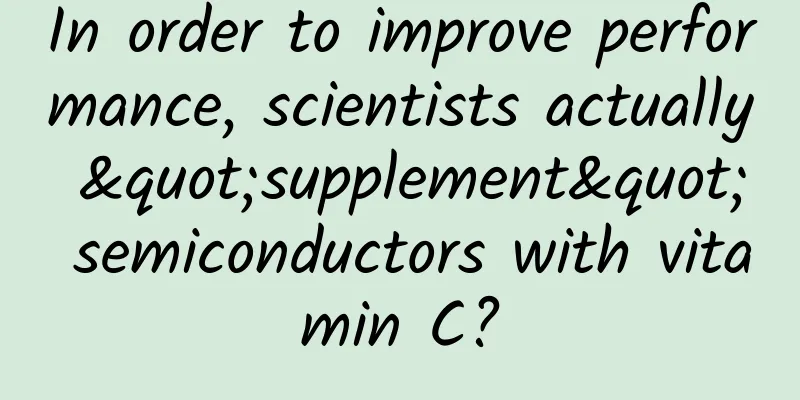In order to improve performance, scientists actually "supplement" semiconductors with vitamin C?

|
Produced by: Science Popularization China Author: Shi Chang (PhD in Physical Chemistry) Producer: China Science Expo Editor's note: In order to understand the latest developments in cutting-edge science and technology, the China Science Popularization Frontier Science Project has launched a series of articles titled "Understanding Top Science Journals", which selects outstanding papers from authoritative journals and interprets them in plain language as soon as possible. Let us broaden our scientific horizons and enjoy the fun of science through the window of top journals. In today's concept of healthy eating, fruits have become an indispensable part. They not only decorate our tables with rich colors, but also tease people's taste buds with their unique nutritional value and taste. Fruits are rich in vitamins, minerals and dietary fiber, which provide comprehensive nutrition for the human body and silently "escort" our health. Vitamin C (Photo source: veer photo gallery) It is worth mentioning that vitamin C contained in fruits plays an important role in the human body with its excellent antioxidant capacity. Vitamin C can effectively remove free radicals in the body, slow down the cell aging process, and protect cardiovascular and cerebrovascular health. Free radicals are molecules or atomic groups containing unpaired electrons. They are highly active and tend to react with other molecules, thereby destroying cell structure and function, causing oxidative stress and cell damage. Vitamin C is like a hardworking guard, building a solid defense line in our body to resist external invasion. Imagine that when you take a bite of a sweet orange, the mouthful of pulp and juice will not only satisfy your taste buds, but also participate in the "battle" of anti-oxidation in the body. So, what is the mechanism of vitamin C's antioxidant ability? Vitamin C, also known as ascorbic acid, is a water-soluble vitamin. The antioxidant mechanism of vitamin C is mainly related to its own strong reducing property and ability to scavenge free radicals. Scavenges free radicals: Vitamin C is able to react with these free radicals and stabilize them by donating electrons, thus preventing them from further damaging cells. Regeneration of other antioxidants: Vitamin C can not only directly remove free radicals, but also indirectly play an antioxidant role by regenerating other antioxidants to form an antioxidant network. For example, vitamin E is the main antioxidant in cell membranes and can prevent lipid peroxidation. However, when vitamin E reacts with free radicals, it itself will turn into an oxidized form, thereby losing its antioxidant capacity. At this time, vitamin C can reduce the oxidized vitamin E and restore its antioxidant activity. Vitamin-rich fruits (Photo source: veer photo gallery) What can we learn from the antioxidant properties of vitamin C? Semiconductors are known as the cornerstone of modern technology and the engine of future innovation. They are not only the soul of the electronic information industry, but also the core driving force for the intelligent era. Among them, organic semiconductors, with their unique molecular structure, flexible design space and environmentally friendly processing methods, have opened up a "highway" leading to high-performance, low-cost, and environmentally friendly electronic devices. However, semiconductors also have their "fragile" side. N-type semiconductors, also known as electronic semiconductors, mainly rely on free electrons to conduct electricity and are important materials for basic electrical components such as light-emitting diodes and complementary circuits. Most n-type semiconductors are very sensitive to water and oxygen in the environment and are easily oxidized, causing the attenuation of electrical performance and stability. This problem has been plaguing the entire semiconductor industry. If n-type semiconductors are "fed" with vitamin C, can they gain the same antioxidant capacity as the human body? It sounds reasonable and feasible. On June 27, 2024, Chinese scientists published an article in the journal Nature Materials on the use of vitamin C to improve the performance and stability of n-type organic semiconductors, providing new ideas and methods for solving the stability problem of n-type organic semiconductors. The research results were published in the journal Nature Materials (Image source: Nature Materials magazine) Taking advantage of the antioxidant effect of vitamin C, the researchers spin-coated vitamin C on the surface of the PTCDI-C8 (an n-type organic semiconductor) film, reducing the photo-oxidative degradation rate of the semiconductor to one-eighteenth of the original rate, greatly improving the antioxidant capacity of the n-type organic semiconductor. How does vitamin C work in n-type organic semiconductors? The researchers used stable and transient fluorescence spectroscopy to track the phosphorescence decay lifetime of singlet oxygen (a form of reactive oxygen). The experimental results showed that after spin coating with vitamin C, the lifetime of singlet oxygen in the air was reduced from 2.7 milliseconds to 1.7 milliseconds, and the oxidative capacity of reactive oxygen was weakened. The antioxidant principle of vitamin C in n-type organic semiconductors is similar to that in organisms. Vitamin C is oxidized into dehydroascorbic acid (DHA) by "self-sacrifice", which can effectively remove reactive oxygen and prevent reactive oxygen from oxidizing semiconductors. The researchers also found that dehydroascorbic acid also has the function of scavenging reactive oxygen species, which means that vitamin C is not only an antioxidant, but its oxidized products can also continuously scavenge reactive oxygen species, bringing better antioxidant effects. Molecular structures of vitamin C, reactive oxygen species and PTCDI-C8; bc. UV-visible absorption spectra; de. Electron spin resonance signal diagram; f. Singlet oxygen phosphorescence lifetime diagram; g. Target analysis of reconstructed SAS; h. Triplet state time trajectory diagram; i. Stabilization mechanism diagram. (Image source: Reference 1) In addition, the researchers also revealed that vitamin C helps the antioxidant capacity of n-type organic semiconductors in a "non-sacrificial" way. Specifically, the introduction of vitamin C and oxidation products into n-type organic semiconductors will not produce new intermediates, but will accelerate the decay rate of triplet excitons (which can react with oxygen to generate reactive oxygen) generated by energy excitation in the semiconductor, effectively blocking the generation process of reactive oxygen. To verify the effect of vitamin C on the stability of n-type organic semiconductor devices, the researchers prepared PTCDI-C8 organic field-effect transistors and exposed them to the environment for 255 days. The results showed that the stability of the transistors coated with vitamin C was significantly improved. When this strategy was applied to the inverter, it showed an ideal inverter voltage and higher gain value, and had excellent stability. What are the application areas of n-type organic semiconductors? Photoelectric field: n-type organic semiconductors play a key role in organic solar cells as electron transport layers. They can efficiently transmit photogenerated electrons and reduce the loss of electrons during the transmission process, thereby improving the conversion efficiency of solar cells. Solar Cells (Photo source: veer photo gallery) Organic field-effect transistor: In organic field-effect transistors, n-type organic semiconductor materials serve as electron transmission channels, achieving efficient control and amplification of electrons, and are widely used in electronic tags, flexible displays, sensors and other fields. Organic photodetectors: n-type organic semiconductors also show unique advantages in organic photodetectors. They can efficiently convert optical signals into electrical signals and have wide applications in optical communications, imaging, and sensing. Folding screen mobile phone (Photo source: veer photo gallery) Conclusion With the rapid development of science and technology, interdisciplinary cooperation has become an important force to promote innovation. The cross-border journey of vitamin C from fruit to semiconductors not only demonstrates the infinite possibilities of the wisdom of nature in the field of high technology, but also reveals to us the huge potential brought by interdisciplinary integration. Looking to the future, we have reason to believe that with the deepening of interdisciplinary cooperation, more similar cross-border applications will emerge. Let us maintain curiosity and an open mind, and witness the bright future brought by scientific and technological innovation together! References 1. Yuan, L., Huang, Y., Chen, X. et al. Improving both performance and stability of n-type organic semiconductors by vitamin C[J]. Nature Materials, 2024. 2.Huang W, Chen J, Yao Y, et al.Vertical organic electrochemical transistors for complementary circuits[J].Nature,2023. 3. Zhang Xiangyu, Wang Mang, Chen Hongzheng, et al. Research and development of organic semiconductor composite photoconductive materials and devices [J]. Progress in Natural Science, 1999. 4. Zhu Changlin, Zhang Wenbin, Sun Peng, et al. Combined immunomodulatory and antioxidant effects of vitamin C and vitamin E[J]. Chinese Journal of Clinical Rehabilitation, 2006. |
>>: What does 5G-A have more than 5G?
Recommend
3 dead, 4 injured! An explosion occurred in a pharmaceutical company in Zhejiang!
According to the website of the Zhejiang Provinci...
China Association of Automobile Manufacturers: Economic Operation of the Automobile Industry in October 2024
In October 2024, my country's automobile prod...
An excellent Android application starts with building a project
[[142392]] 1. Project Structure The MVP model is ...
When spring comes and flowers bloom, be sure to tighten these safety "strings" →
As spring approaches and the temperature graduall...
The secret of a brand becoming popular at a low cost
Generally speaking, marketing will plan a series ...
Can lard protect cardiovascular system, detoxify, prevent cancer, etc.? People who eat it often must read this!
Author: Ruan Guangfeng, Director of the Science a...
Analyzing the user incentive system of Qutoutiao!
On September 14, 2018, Qutoutiao was listed on th...
Advertising is a method, public relations is the goal
Two small things happened in the industry recentl...
Tik Tok live broadcast operation skills (super detailed)
The short video live broadcast room started a new...
2016 Apple App Store Japan Annual Game List
Today, Apple released the 2016 game list for Japa...
Dismantling the virtual product project of Baidu's high-profit blue ocean, with a profit of 300+ per order
Friends who work in the Internet industry know th...
Is it really better to wear a tighter sports bra? The answer is not what you think!
Myth: "When wearing a sports bra, a tighter ...
Parent-child experience activity planning (commercial operation case)
The author of this article shares an activity pla...
"Red Coast Base" is more than just science fiction: We are looking for alien civilizations in the radio waves
"Red Coast Base" is more than just scie...
Android Date Time Picker
[[185911]] Many applications have date pickers, s...







![Analysis of mainstream [information flow advertising] channels, the war is about to break out!](/upload/images/67cc3624c689b.webp)

